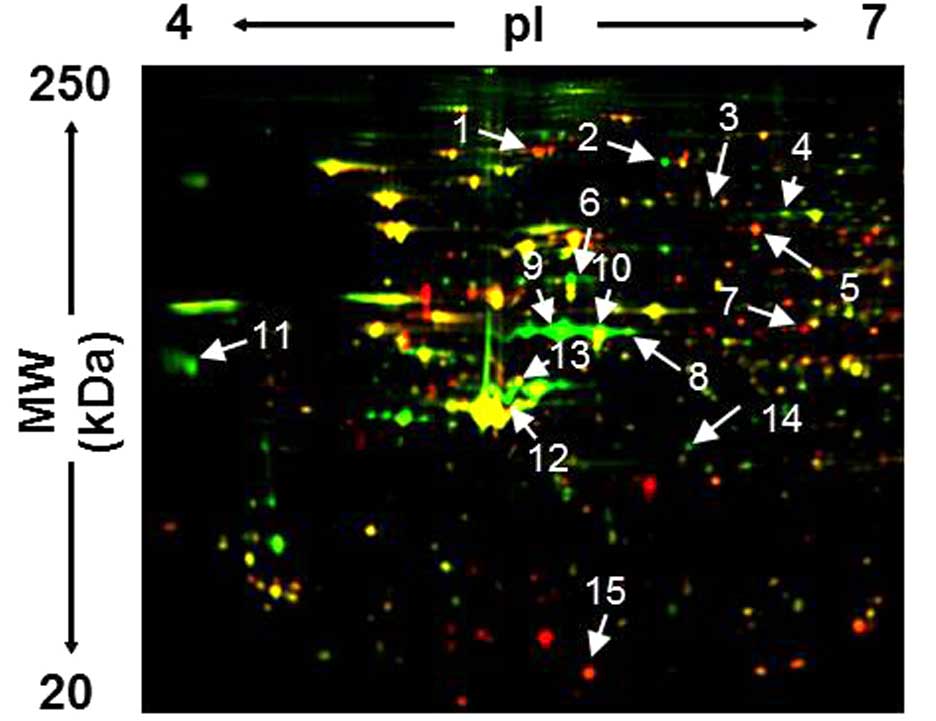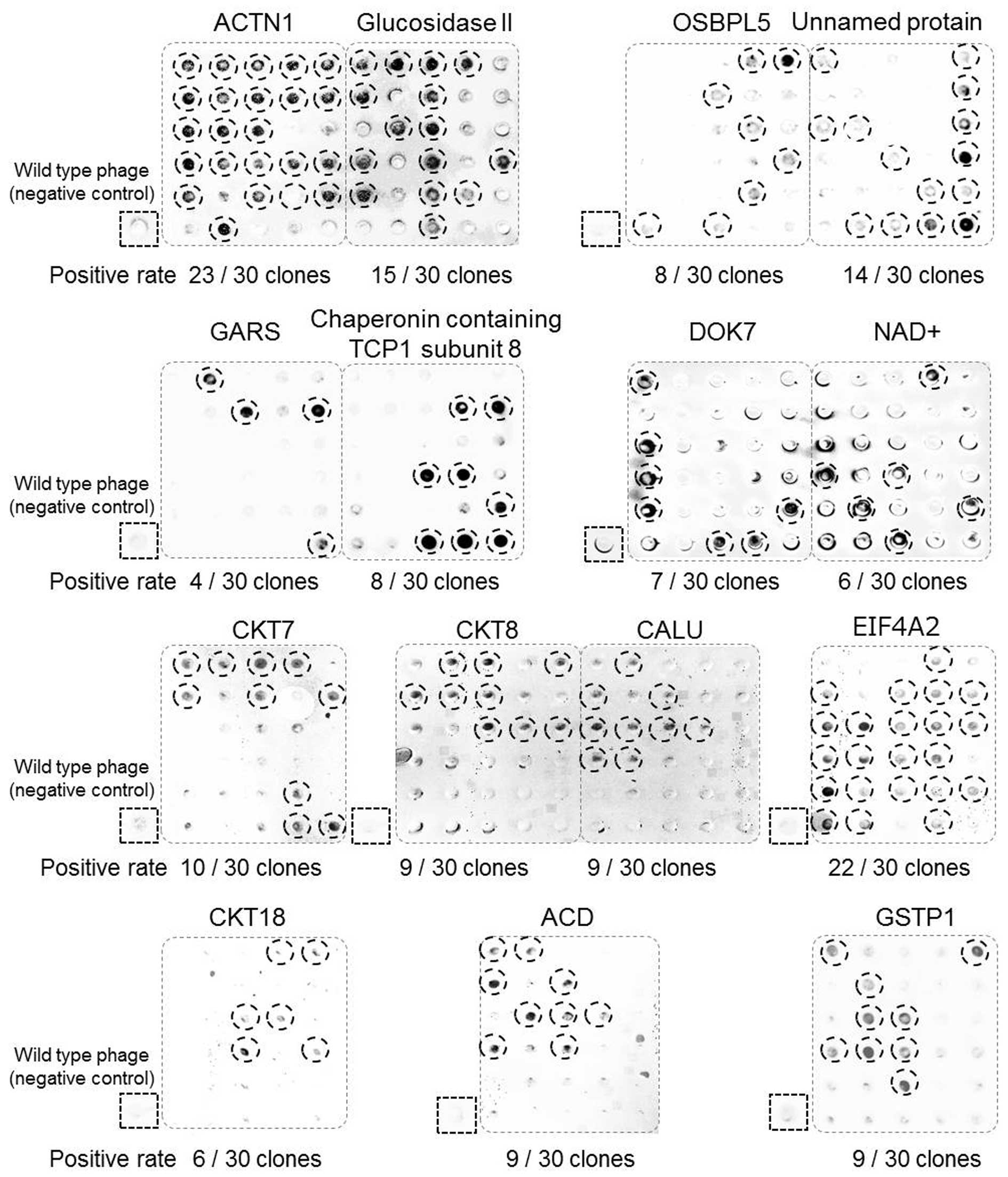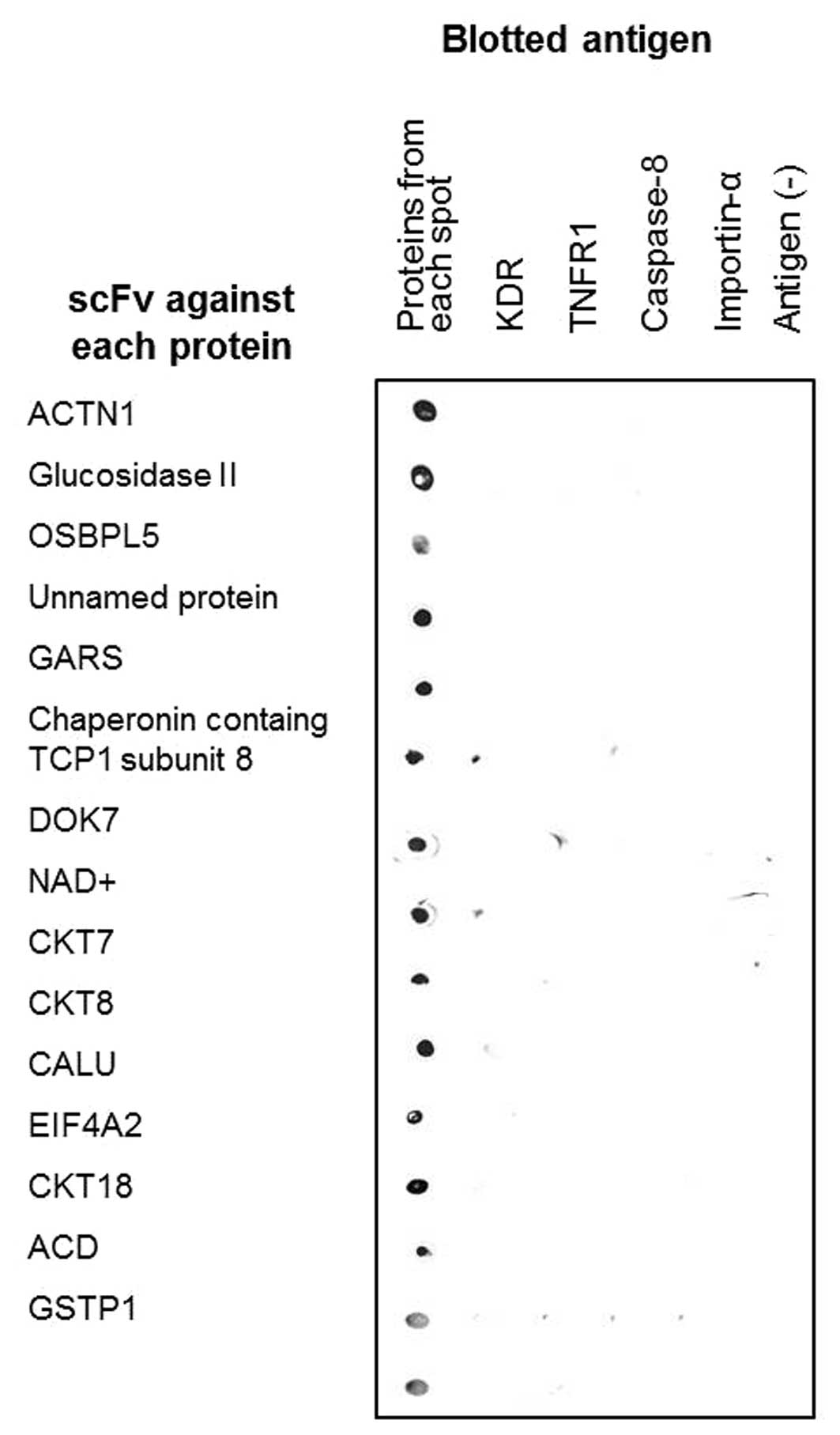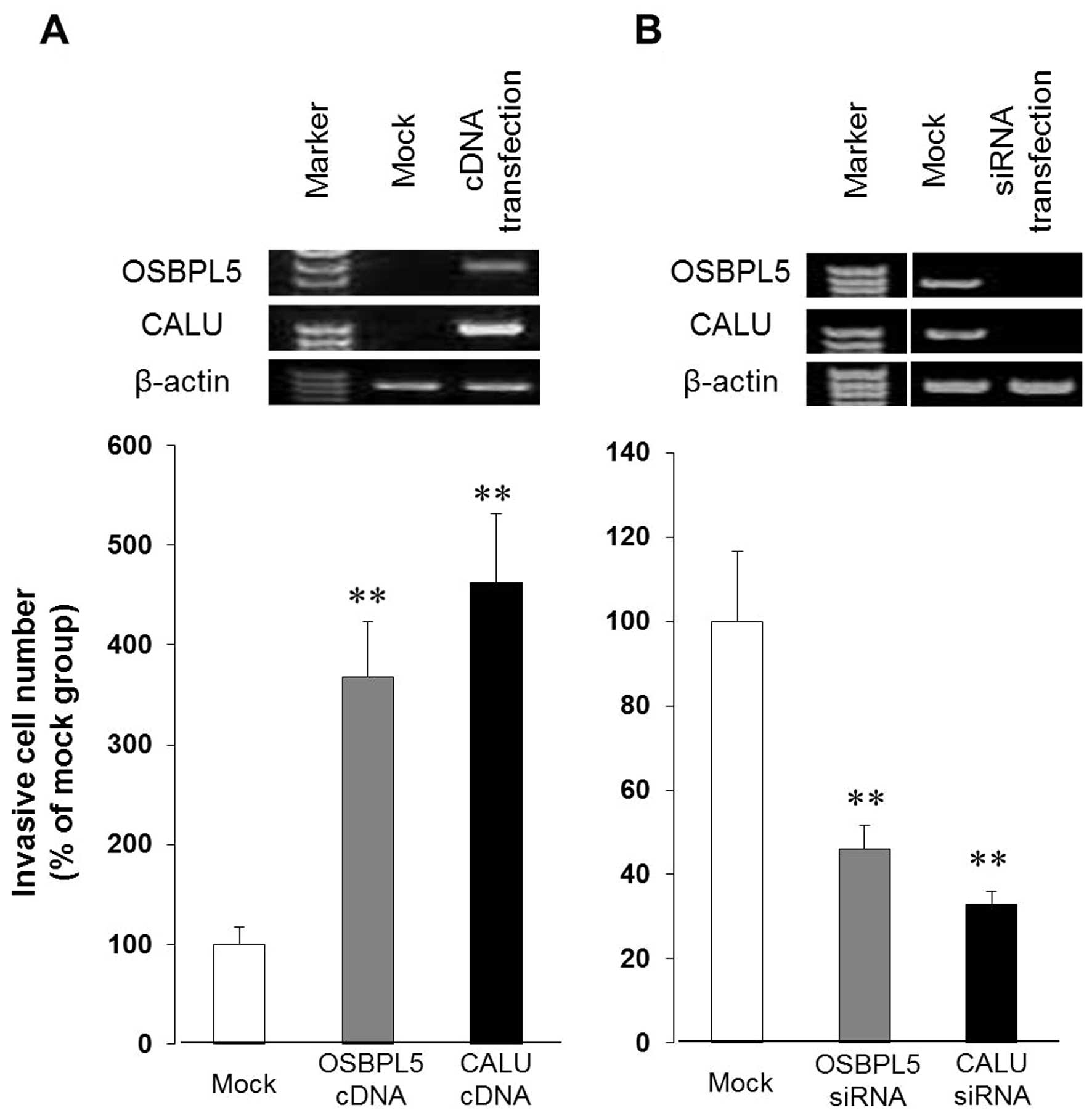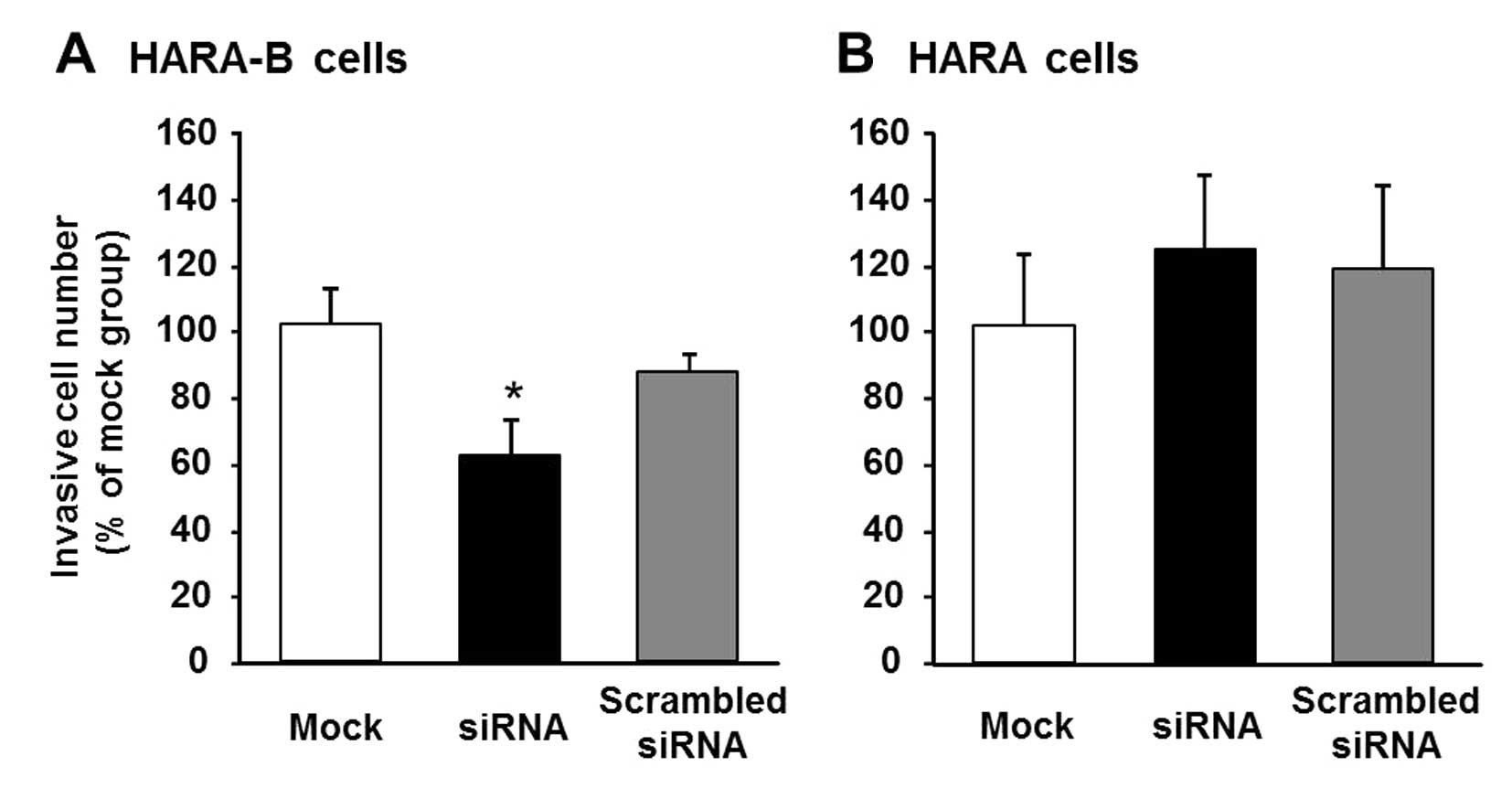Identification and evaluation of metastasis-related proteins, oxysterol binding protein-like 5 and calumenin, in lung tumors
- Authors:
- Published online on: May 11, 2015 https://doi.org/10.3892/ijo.2015.3000
- Pages: 195-203
Abstract
Introduction
Lung cancer is the leading cause of cancer-related deaths in the world, accounting for ~17.6% of all deaths from cancer, 5-year survival rate for which is only 8.9–15% (1). Particularly, metastasis is one of the poorest prognosis factors in lung cancer, and is the main cause that leads to treatment failure and death (2). Thus, it is imperative to overcome metastasis in order to decrease lung cancer related mortality. Several mechanistic studies have revealed that various proteases (3,4), chaperones (5,6), epithelial-mesenchymal transition (EMT) (7,8) and lipid metabolism (9,10) may be associated with metastasis. However, these results are not exhaustive, and no promising candidate has been identified so far for the accurate diagnosis, prediction and regulation of metastasis in clinical settings.
In recent years, proteomic analysis has become a preferred method for seeking diagnostic markers or drug targets (11). However, in general, a lot of proteins are differentially-expressed in disease samples. Thus, the rate limiting step is to select the most useful proteins from many differentially-expressed proteins. In order to circumvent this problem, we have developed an ‘antibody proteomics technology’ to accelerate identifying proteins which would be useful for elucidating the molecular mechanism of metastasis and developing accurate diagnosis or effective therapy as well for metastasis (12). This technology enabled us to comprehensively and rapidly generate monoclonal antibodies against candidate proteins, including unknown proteins, for which no commercially produced antibodies are available, by screening a single-chain variable fragment (scFv) phage display library using small amount of proteins, which were directly extracted from a 2-dimensional gel used for the proteome analysis. Therefore, by immunostaining a tissue microarray (TMA), a glass slide containing many clinical samples (such as tumor and normal tissues) and clinical information [such as age, gender, clinical stage and lymph node (LN) metastasis], it is possible to validate each candidate protein by analyzing the correlation between the expression profile of each candidate protein and clinical information (13–15). As reported previously, we have successfully used this technology to quickly identify useful breast cancer-related proteins, thus suggesting its practical usefulness (16–18).
We applied the above described technology to lung cancer cells with different metastatic abilities for subsequent identification of lung cancer metastasis-related proteins, which could be used for elucidating the molecular mechanism of metastasis, and developing novel diagnostic methods and therapies for metastasis.
Materials and methods
Cell cultures
The human lung cancer cell lines, RERF-LC-KJ, RERF-LC-MS, HARA and HARA-B, were purchased from the Japanese Collection of Research Bioresources Cell Bank (Osaka, Japan). All cells were cultured in RPMI-1640 medium with 10% fetal calf serum (FCS) at 37°C in a humidified atmosphere of 5% CO2.
Two-dimensional differential in-gel electrophoresis (2D-DIGE) analysis
RERF-LC-MS and RERF-LC-KJ cell lysates were labelled with the Cy3 and Cy5 protein labeling dyes (GE Healthcare Bio-Sciences AB, Uppsala, Sweden), respectively. The labelled samples were mixed and applied to a 24-cm immobilized pH gradient gel strip (IPG-strip pH 4.0–7.0) for first dimension separation. For the second dimension separation, the IPG-strips were placed on the top of the SDS-PAGE gels. After electrophoresis, gels were scanned with a laser fluoroimager (Typhoon Trio, GE Healthcare Bio-Sciences AB, Uppsala, Sweden). Quantitative analysis of protein spots was carried out with Decyder-DIA software (GE Healthcare Bio-Sciences AB). The samples for the spot-picking gel were prepared without labelling. The spot-picking gel was scanned after staining with deep purple total protein stain reagent (GE Healthcare Bio-Sciences AB). The antigen spots of interest were picked using an Ettan Spot Picker (GE Healthcare Bio-Sciences AB). Proteins were extracted by solubilizing the picked gel pieces using 88 mM sodium periodide for nitrocellulose panning experiment.
Protein identification by mass spectrometry analysis
Picked gel pieces were in-gel digested with trypsin overnight. The digested peptides were dried and resuspended in 10 μl of 0.1% trifluoroacetic acid, following which they were purified using ZipTip μC18 pipette tips (EMD Millipore, Billerica, MA, USA). The digested peptides were analyzed by matrix-assisted laser desorption ionization time-of-flight mass spectrometry (MALDI-TOF/MS; AutoflexII, Bruker Daltonics Inc., Billerica, MA, USA). Peptide mass fingerprints were used for searching public protein primary sequence databases to identify proteins. The Mascot search engine (http://www.matrixscience.com) was initially used to query the entire theoretical tryptic peptide.
Isolation of monoclonal antibodies by panning
To generate monoclonal antibodies, panning of the scFv phage display library was performed using nitrocellulose membrane blots as previously described (12). Briefly, a portion of each protein extracted from the 2D-DIGE spots was immobilized onto a nitrocellulose membrane using the Bio-Dot Microfiltration apparatus (Bio-Rad Laboratories, Hercules, CA, USA), and these were then incubated with the blocking solution (10% skimmed milk, 25% glycerol) for 2 h. The non-immune scFv phage display library (19) was applied to each well of the Bio-Dot Microfiltration apparatus (1012 CFU/well). After 2–3-h incubation, each well was washed ten times with Tris-buffered saline containing 0.05% Tween-20 (TBST). Bound phage was then eluted with 100 mM triethylamine. The eluted phage was used to infect log phase E. coli TG1 cells and cells were grown for 1 h at 37°C. Output phage titer was measured by counting the number of infected cells on Petrifilm (3M Corporate, St. Paul, MN, USA). The panning cycle was repeated four times.
Phage dot blot ELISA
For each identified target protein, 30 individual phage-infected TG1 clones were picked and grown separately to propagate phages, which were then purified by precipitation with polyethylene glycol. The purified phages (1012 CFU/well) were incubated with the respective target proteins, which were extracted from the 2D-DIGE protein spots and immobilized using the Bio-Dot Microfiltration apparatus (Bio-Rad Laboratories) as described above. Phages bound to each target protein were visualized using an HRP-conjugated anti-M13 monoclonal antibody (GE Healthcare Bio-Sciences AB). For specificity assay, human recombinant kinase insert domain receptor (KDR), tumor necrosis factor receptor 1 (TNFR1) (R&D Systems Inc., Minneapolis, MN, USA), caspase-8 and importin-α were used as antigens.
Immunohistochemical analysis of TMA
Human lung cancer and normal TMAs (Super BioChips Laboratories, Seoul, Korea) were deparaffinized in xylene and rehydrated in ethanol. After heat-induced epitope retrieval using the Target Retrieval Solution pH 9.0 (Dako, Glostup, Denmark), endogenous peroxidase was blocked with 0.3% H2O2 for 5 min. The slides were then incubated with an scFv-displaying phage (1012 CFU/ml) for 30 min. After washing three times with TBST, the slides were incubated for 30 min with Envision+ Dual Link (Dako). Finally, the slides were washed three times with TBST and treated with 3,3′-diaminobenzidine, and then counterstained with Mayer’s hematoxylin. For statistical analysis, study samples were divided into high and low expression groups based on the following two criteria. In terms of distribution, the percentage of positive cells in a population of all tumor cells was scored as 0 (0%), 1 (1–50%), and 2 (51–100%). In terms of quantity, the signal intensity was scored as 0 (no signal), 1 (weak), 2 (moderate) or 3 (marked). Cases with a total score of ≥3 were classified into the high expression group.
Manipulation of gene expression by plasmid or siRNA transfection
For overexpression and knockdown of gene expression, cells were transfected with an expression plasmid containing the cDNA of the gene or with a gene-specific siRNA, respectively. Transfection of cells with OSBPL5 and CALU expression plasmids (Life Technologies, Carlsbad, CA, USA) was carried out using Lipofectamine LTX (Life Technologies) according to the manufacturer’s instructions. Briefly, RERF-LC-MS cells were plated in 100-mm dish. The next day, 15 μg of plasmid was mixed with 15 μl plus reagent in 3 ml Opti-MEM. After 15-min incubation, 37.5 μl lipofectamine LTX was added, incubated for 30 min, and then the DNA-lipofectamine complex was added to the cells. The cells were used in invasion assay after 24-h incubation. Transfection of cells with gene specific siRNA (Qiagen, Montgomery Country, MD, USA) was carried out using HiPerFect Transfection Reagent (Qiagen) according to the manufacturer’s instructions. Briefly, RERF-LC-KJ, HARA-B and HARA cells were plated in a 100-mm dish. The next day, 50 nM siRNA was mixed with 40 μl HiPerFect Transfection reagent in 3 ml Opti-MEM. After 10-min incubation, the complex was added to the cells. Transfected cells were used in invasion assay after 24-h incubation. The cells treated with only transfection reagents are regarded as mock cells. Expression levels of OSBPL5 and CALU genes in cells, transfected either with the respective cDNA-expression plasmid or with the indicated siRNA, were determined using the RT-PCR method.
Invasion assay
Invasion assay was performed using a 96-well BME cell invasion assay kit (Trevigen Inc., Gaithersburg, MD, USA). The upper chambers of the 96-well cell culture inserts were washed with serum-free medium, coated with 50 μl of basal membrane extract (BME) and then dried overnight at 37°C. One million cells in serum-free media were added to the upper chambers and 150 μl of medium containing 10% FCS was added to the lower chambers. The invasion chambers were kept for 72 h at 37°C in the cell culture incubator. Non-invasive cells on the upper insert membranes were removed by gentle rubbing. Invasive cells on the lower insert membranes were stained with calcein-AM solution, and were assayed by measuring the fluorescence intensity using ARVO MX (Perkin-Elmer, Waltham, MA, USA).
Results
2D-DIGE analysis and isolation of antibodies against differentially-expressed proteins using non-immune scFv-displaying phage library
In order to identify metastasis-related proteins in lung cancer, we performed 2D-DIGE analysis of lung cancer cells with high LN metastatic potential (RERF-LC-KJ) (20,21) and lung cancer cells with non-metastatic potential (RERF-LC-MS) (22,23). Fig. 1 shows the fluorescent image of a representative 2D-gel containing proteins expressed in these cells. Quantitative analysis identified 15 protein spots whose intensities altered >2-fold in RERF-LC-KJ cells compared to in RERF-LC-MS cells. Proteins from these spots were then identified by MALDI-TOF/MS (Table I). Thus, a portion of each extracted protein was immobilized by dot-blotting onto a nitrocellulose membrane and this membrane was used for 4-cycle panning of a non-immune scFv-displaying phage library. The output/input ratio (titer of the recovered phage library after the panning/titer of the library before the panning) was increased as the panning round was repeated (Table II). This elevated output/input ratio indicated the enrichment of antigen-binding scFv clones. A total of 30 clones (for each target protein) were randomly picked from the fourth panning output and their bindings to respective antigens were verified by phage dot blot ELISA. Results shown in Fig. 2 demonstrated that each one of the 15 target proteins were able to bind to multiple number of scFv antibody phages. From these positive clones, we selected the ones displaying highest affinities for evaluating their respective specificity. Fig. 3 showed the specificity evaluation results, which demonstrated that all selected scFv clones specifically recognized their respective target proteins, but not KDR, TNFR1, caspase-8 and importin-α, which were used as negative control antigens. Thus, by using the antibody proteomics technology described in this study, we isolated monoclonal antibodies to 15 metastasis-related target proteins and validated their specificity.
Table IIEnrichment and isolation of scFv antibodies to identified proteins from scFv phage display libraries. |
TMA analysis
In order to identify and select the metastasis-related proteins in lung cancer from a large pool of candidate proteins, expression profiles of the identified proteins were determined by TMA analysis using the phage antibodies. The TMA used in this study contained tissues from 46 lung cancer cases with information on LN metastasis. Examination of the expression profile of each antigen revealed that glucosidase II, unnamed protein product, glycyl-tRNA synthetase, chaperonin containing TCP1 subunit 8 and eukaryotic initiation factor 4AII were not expressed in the clinical samples of lung tumor tissues, suggesting that these proteins were only produced in the cancer cell lines. However, ten other proteins were expressed in the clinical samples of lung tumor tissues (Table III). Results summarized in Table III also show that the expression ratio of OSBPL5 and CALU, among all the expressed candidate proteins, were significantly higher in the LN metastasis-positive cases than in the metastasis-negative cases (p=0.0156 and 0.0055, respectively). Moreover, 15 cases out of a total of 46 lung tumor cases were OSBPL5 and CALU double-positive, and 12 of them (80% of OSBPL5 and CALU double-positive cases) were LN metastasis-positive. Therefore, the correlation analysis between protein expression and clinicopathological characteristic revealed significant association between OSBPL5 and CALU expression and LN metastasis in lung tumors.
Effects of OSBPL5 and CALU expression (overexpression or knockdown) on invasiveness of cells
To delineate the functions of OSBPL5 and CALU in metastatic lung cancer, we analyzed the effects of gene overexpression and gene knockdown on lung cancer cell invasiveness, a main characteristic of metastasis. First, we transfected RERF-LC-MS cells with either OSBPL5 expression plasmid pCMV-OSBPL5 or with CALU expression plasmid pCMV-CALU, and confirmed that OSBPL5 or CALU, respectively, was indeed overexpressed in these cells. Test results for the invasiveness of cells, as shown in Fig. 4A, clearly indicate that the RERF-LC-MS cells overexpressing either OSBPL5 or CALU were significantly more invasive than the cells transfected with the control plasmid. Next, we transfected RERF-LC-KJ cells with OSBPL5 siRNA or CALU siRNA and then examined the invasiveness of cells in which these genes were knocked down. As shown in Fig. 4B, the invasiveness of cells transfected with either OSBPL5 or CALU siRNA was significantly lower compared to that of the mock group, while there was no difference in cell proliferation (data not shown). Knockdown of expression of either OSBPL5 or CALU by transfection of RERF-LC-KJ cells with the respective siRNA did not diminish the invasiveness of cells completely, suggesting that the expression of OSBPL5 and CALU are probably partly responsible for the increased invasiveness of cells. An inhibitory effect of the cell invasiveness by OSBPL5 gene-knockdown was also observed in the invasive lung cancer cells (HARA-B), which were derived from a bone lesion formed after the intracardiac inoculation of HARA cells (Fig. 5). These results suggested that OSBPL5 and CALU might play a critical role in facilitating invasiveness of lung cancer cells.
Expression analysis of OSBPL5 and CALU in normal lung tissues
To further determine the usefulness of OSBPL5 and CALU as diagnostic or therapeutic targets, we analyzed the expression levels of these proteins in normal lung tissues. TMA analysis using lung cancer and normal lung tissues showed that OSBPL5 and CALU were specifically expressed in the lung tumor tissues (Table IV). Our observation that both OSBPL5 and CALU were specifically expressed in the lung tumor tissues suggested that these two proteins might have some functional roles in lung cancer cells. Thus, they could either help in elucidating the underlying mechanism of lung cancer or serve as targets for developing therapies against lung cancer.
Table IVMicroarray analysis of lung cancer and normal tissues using scFv-expressing phages against candidate proteins. |
Discussion
In this study, we successfully identified OSBPL5 and CALU as metastasis-related proteins in lung tumors, which were highly expressed in metastasis-positive cases and facilitated invasiveness of lung cancer cells. This was achieved by carefully selecting the target proteins from a large pool of differentially-expressed proteins rapidly and efficiently.
OSBPL5 is a member of the oxysterol binding protein (OSBP) family (24). OSBP is a cytosolic mammalian protein that binds to an oxysterol ligand and interacts with the golgi membrane and is involved in vesicle transport, lipid metabolism, and signal transduction. Previous studies suggested that metabolism-related molecules were associated with LN metastasis, for example, association of angiopoietin-like protein 4 (25) or acid phosphatase 6 (26) in esophageal squamous cell carcinoma and heart-type fatty acid-binding protein in gastric carcinoma (27). It was also shown that statins, inhibitors of 3-hydroxy-3-metylglutaryl coenzyme A (HMG-CoA) reductase, inhibited metastasis (28). These results suggested that OSBPL5, a metabolism-related molecule, might be involved in metastasis. Consistent with this notion, it was reported earlier that OSBPL5 expression is related to invasion and poor prognosis of pancreatic cancer (29,30). Thus, OSBPL5 may play a role in facilitating metastasis of lung cancer, similar to that suggested for pancreas cancer.
CALU is a calcium binding protein in the endoplasmic reticulum (ER) and is involved in such ER functions as protein folding and sorting (31). It has been reported earlier that heat shock proteins were associated with LN metastasis (32,33), suggesting that chaperones such as CALU could also play a role in metastasis. Unlike OSBPL5, CALU was found to be downregulated in cancer cell lines with high metastatic potential and were found in head and neck (34), as well as in liver cancer (35). The function of CALU in lung cancer may, however, be different from that in head and neck cancer and liver cancer.
In the cases where both proteins were expressed, 80% were found to be LN metastasis-positive cases. Moreover, these proteins were expressed only in lung tumor tissues, not in normal lung tissues. Therefore, these findings suggested that they could be promising targets for accurate diagnosis and prediction of metastasis; however, further experiments, such as a prospective study, are required. Furthermore, gene knockdown experiments showed that knocking down the expression of OSBPL5 or CALU inhibited invasiveness of lung cancer cells. These results suggested that OSBPL5 and CALU might also be considered as useful target proteins for metastasis therapy, although further experiments, such as their biodistribution analyses and therapeutic experiments, are needed.
In conclusion, by using an antibody proteomics technology, we identified OSBPL5 and CALU as metastasis-related proteins in lung tumors. Furthermore, we have revealed that OSBPL5 and CALU promoted the invasiveness of lung cancer cells. We hope that the data presented would contribute to the elucidation of molecular mechanism of metastasis and help in developing diagnosis markers and drugs against metastasis in lung cancer.
Acknowledgements
This study was supported in part by Grants-in-Aid for Scientific Research from the Project for Development of Innovative Research on Cancer Therapeutics, the Ministry of Education, Culture, Sports, Science and Technology of Japan, and from the Japan Society for the Promotion of Science. This study was also supported in part by Health Labor Sciences Research Grants from the Ministry of Health, Labor and Welfare of Japan.
Abbreviations:
|
OSBPL5 |
oxysterol binding protein-like 5 |
|
CALU |
calumenin |
|
scFv |
single-chain variable fragment |
|
TMA |
tissue microarray |
|
2D-DIGE |
two-dimensional differential in-gel electrophoresis |
|
MS |
mass spectrometry |
|
TBST |
Tris-buffered saline containing Tween-20 |
|
KDR |
kinase insert domain receptor |
|
TNFR1 |
tumor necrosis factor receptor 1 |
References
|
Parkin DM, Bray F, Ferlay J and Pisani P: Global cancer statistics, 2002. CA Cancer J Clin. 55:74–108. 2005. View Article : Google Scholar : PubMed/NCBI | |
|
Steeg PS: Metastasis suppressors alter the signal transduction of cancer cells. Nat Rev Cancer. 3:55–63. 2003. View Article : Google Scholar : PubMed/NCBI | |
|
Rochefort H, Capony F and Garcia M: Cathepsin D: A protease involved in breast cancer metastasis. Cancer Metastasis Rev. 9:321–331. 1990. View Article : Google Scholar : PubMed/NCBI | |
|
Zheng S, Chang Y, Hodges KB, Sun Y, Ma X, Xue Y, Williamson SR, Lopez-Beltran A, Montironi R and Cheng L: Expression of KISS1 and MMP-9 in non-small cell lung cancer and their relations to metastasis and survival. Anticancer Res. 30:713–718. 2010.PubMed/NCBI | |
|
Koga F, Kihara K and Neckers L: Inhibition of cancer invasion and metastasis by targeting the molecular chaperone heat-shock protein 90. Anticancer Res. 29:797–807. 2009.PubMed/NCBI | |
|
Tsutsumi S and Neckers L: Extracellular heat shock protein 90: A role for a molecular chaperone in cell motility and cancer metastasis. Cancer Sci. 98:1536–1539. 2007. View Article : Google Scholar : PubMed/NCBI | |
|
Kang Y and Massagué J: Epithelial-mesenchymal transitions: Twist in development and metastasis. Cell. 118:277–279. 2004. View Article : Google Scholar : PubMed/NCBI | |
|
Tsuji T, Ibaragi S and Hu GF: Epithelial-mesenchymal transition and cell cooperativity in metastasis. Cancer Res. 69:7135–7139. 2009. View Article : Google Scholar : PubMed/NCBI | |
|
Lee GH, Yan C, Shin SJ, Hong SC, Ahn T, Moon A, Park SJ, Lee YC, Yoo WH, Kim HT, et al: BAX inhibitor-1 enhances cancer metastasis by altering glucose metabolism and activating the sodium-hydrogen exchanger: The alteration of mitochondrial function. Oncogene. 29:2130–2141. 2010. View Article : Google Scholar : PubMed/NCBI | |
|
Torosian M, Charland S and Lappin J: Biochemical modulation of tumor-growth, metastasis and host metabolism. Oncol Rep. 2:1141–1145. 1995.PubMed/NCBI | |
|
Hanash S: Disease proteomics. Nature. 422:226–232. 2003. View Article : Google Scholar : PubMed/NCBI | |
|
Imai S, Nagano K, Yoshida Y, Okamura T, Yamashita T, Abe Y, Yoshikawa T, Yoshioka Y, Kamada H, Mukai Y, et al: Development of an antibody proteomics system using a phage antibody library for efficient screening of biomarker proteins. Biomaterials. 32:162–169. 2011. View Article : Google Scholar | |
|
Yamashita T, Nagano K, Kanasaki S, Maeda Y, Furuya T, Inoue M, Nabeshi H, Yoshikawa T, Yoshioka Y, Itoh N, et al: Annexin A4 is a possible biomarker for cisplatin susceptibility of malignant mesothelioma cells. Biochem Biophys Res Commun. 421:140–144. 2012. View Article : Google Scholar : PubMed/NCBI | |
|
Yamashita T, Okamura T, Nagano K, Imai S, Abe Y, Nabeshi H, Yoshikawa T, Yoshioka Y, Kamada H, Tsutsumi Y, et al: Rho GDP-dissociation inhibitor alpha is associated with cancer metastasis in colon and prostate cancer. Pharmazie. 67:253–255. 2012.PubMed/NCBI | |
|
Yoshida Y, Yamashita T, Nagano K, Imai S, Nabeshi H, Yoshikawa T, Yoshioka Y, Abe Y, Kamada H, Tsutsumi Y, et al: Limited expression of reticulocalbin-1 in lymphatic endothelial cells in lung tumor but not in normal lung. Biochem Biophys Res Commun. 405:610–614. 2011. View Article : Google Scholar : PubMed/NCBI | |
|
Nagano K, Kanasaki S, Yamashita T, Maeda Y, Inoue M, Higashisaka K, Yoshioka Y, Abe Y, Mukai Y, Kamada H, et al: Expression of Eph receptor A10 is correlated with lymph node metastasis and stage progression in breast cancer patients. Cancer Med. 2:972–977. 2013. View Article : Google Scholar | |
|
Nagano K, Maeda Y, Kanasaki S, Watanabe T, Yamashita T, Inoue M, Higashisaka K, Yoshioka Y, Abe Y, Mukai Y, et al: Ephrin receptor A10 is a promising drug target potentially useful for breast cancers including triple negative breast cancers. J Control Release. 189:72–79. 2014. View Article : Google Scholar : PubMed/NCBI | |
|
Nagano K, Yamashita T, Inoue M, Higashisaka K, Yoshioka Y, Abe Y, Mukai Y, Kamada H, Tsutsumi Y and Tsunoda S: Eph receptor A10 has a potential as a target for a prostate cancer therapy. Biochem Biophys Res Commun. 450:545–549. 2014. View Article : Google Scholar : PubMed/NCBI | |
|
Imai S, Mukai Y, Nagano K, Shibata H, Sugita T, Abe Y, Nomura T, Tsutsumi Y, Kamada H, Nakagawa S, et al: Quality enhancement of the non-immune phage scFv library to isolate effective antibodies. Biol Pharm Bull. 29:1325–1330. 2006. View Article : Google Scholar : PubMed/NCBI | |
|
Teraoka S, Kyoizumi S, Seyama T, Yamakido M and Akiyama M: Scid mice model for the in-vivo study of human oncotherapy -studies on the growth and metastasis of human lung-cancer. Int J Oncol. 5:501–508. 1994.PubMed/NCBI | |
|
Teraoka S, Kyoizumi S, Seyama T, Yamakido M and Akiyama M: A novel SCID mouse model for studying spontaneous metastasis of human lung cancer to human tissue. Jpn J Cancer Res. 86:419–423. 1995. View Article : Google Scholar : PubMed/NCBI | |
|
Hirai K, Shimada H, Ogawa T and Taji S: The spread of human lung cancer cells on collagens and its inhibition by type III collagen. Clin Exp Metastasis. 9:517–527. 1991. View Article : Google Scholar : PubMed/NCBI | |
|
Kuramochi M, Fukuhara H, Nobukuni T, Kanbe T, Maruyama T, Ghosh HP, Pletcher M, Isomura M, Onizuka M, Kitamura T, et al: TSLC1 is a tumor-suppressor gene in human non-small-cell lung cancer. Nat Genet. 27:427–430. 2001. View Article : Google Scholar : PubMed/NCBI | |
|
Fairn GD and McMaster CR: Emerging roles of the oxysterol-binding protein family in metabolism, transport, and signaling. Cell Mol Life Sci. 65:228–236. 2008. View Article : Google Scholar | |
|
Shibata K, Nakayama T, Hirakawa H, Hidaka S and Nagayasu T: Clinicopathological significance of angiopoietin-like protein 4 expression in oesophageal squamous cell carcinoma. J Clin Pathol. 63:1054–1058. 2010. View Article : Google Scholar : PubMed/NCBI | |
|
Ando T, Ishiguro H, Kuwabara Y, Kimura M, Mitsui A, Kurehara H, Sugito N, Tomoda K, Mori R, Takashima N, et al: Expression of ACP6 is an independent prognostic factor for poor survival in patients with esophageal squamous cell carcinoma. Oncol Rep. 15:1551–1555. 2006.PubMed/NCBI | |
|
Hashimoto T, Kusakabe T, Sugino T, Fukuda T, Watanabe K, Sato Y, Nashimoto A, Honma K, Kimura H, Fujii H, et al: Expression of heart-type fatty acid-binding protein in human gastric carcinoma and its association with tumor aggressiveness, metastasis and poor prognosis. Pathobiology. 71:267–273. 2004. View Article : Google Scholar : PubMed/NCBI | |
|
Hindler K, Cleeland CS, Rivera E and Collard CD: The role of statins in cancer therapy. Oncologist. 11:306–315. 2006. View Article : Google Scholar : PubMed/NCBI | |
|
Ishikawa S, Nagai Y, Masuda T, Koga Y, Nakamura T, Imamura Y, Takamori H, Hirota M, Funakosi A, Fukushima M, et al: The role of oxysterol binding protein-related protein 5 in pancreatic cancer. Cancer Sci. 101:898–905. 2010. View Article : Google Scholar : PubMed/NCBI | |
|
Koga Y, Ishikawa S, Nakamura T, Masuda T, Nagai Y, Takamori H, Hirota M, Kanemitsu K, Baba Y and Baba H: Oxysterol binding protein-related protein-5 is related to invasion and poor prognosis in pancreatic cancer. Cancer Sci. 99:2387–2394. 2008. View Article : Google Scholar : PubMed/NCBI | |
|
Honoré B: The rapidly expanding CREC protein family: Members, localization, function, and role in disease. BioEssays. 31:262–277. 2009. View Article : Google Scholar : PubMed/NCBI | |
|
Cappello F, David S, Rappa F, Bucchieri F, Marasà L, Bartolotta TE, Farina F and Zummo G: The expression of HSP60 and HSP10 in large bowel carcinomas with lymph node metastase. BMC Cancer. 5:1392005. View Article : Google Scholar : PubMed/NCBI | |
|
Castilla C, Congregado B, Conde JM, Medina R, Torrubia FJ, Japón MA and Sáez C: Immunohistochemical expression of Hsp60 correlates with tumor progression and hormone resistance in prostate cancer. Urology. 76:1017.e1–6. 2010. View Article : Google Scholar | |
|
Wu W, Tang X, Hu W, Lotan R, Hong WK and Mao L: Identification and validation of metastasis-associated proteins in head and neck cancer cell lines by two-dimensional electrophoresis and mass spectrometry. Clin Exp Metastasis. 19:319–326. 2002. View Article : Google Scholar : PubMed/NCBI | |
|
Ding SJ, Li Y, Shao XX, Zhou H, Zeng R, Tang ZY and Xia QC: Proteome analysis of hepatocellular carcinoma cell strains, MHCC97-H and MHCC97-L, with different metastasis potentials. Proteomics. 4:982–994. 2004. View Article : Google Scholar : PubMed/NCBI |



